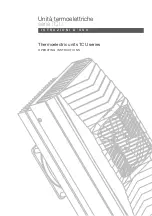
18
18
18
18
18
A P E R T U R A
C H I U S U R A
A
A
A
A
A
LED di segnalazione
Signal LED
LED de signalisation
Anzeige-LED
LED de señal
3
3
3
3
3
PROGRAMMAZIONE FINECORSA /
LIMIT SWITCH PROGRAMMING / PROGRAMMATION FIN DE COURSE
ENDAUSSCHALTER-PROGRAMMIER / PROGRAMACION FINAL DE CARRERA
1)Dopo aver eseguito i collegamenti elettrici e selezionato
le funzioni desiderate (pag 22÷24), alimentare i motori
con tensione a 230V sui relativi morsetti dei trasformatori.
Le ante procederanno a velocità rallentata in chiusura (in
caso contrario togliere la tensione e invertire i fili del
motore).
N.B.: l'automazione PB2100 è predisposta dalla CAME
per l'utilizzo dei bracci richiesti sull'ordine specifico, nel
caso di modifica in fase di installazione, invertire i fili del
motore.
Attenzione: Nel caso di programmazione con fasi
invertite, le ante possono muoversi pericolosamente.
Dopo tale verifica procedere con la programmazione.
2)Inserire i dip-switch 10 in ON sia su MASTER che sulla
SLAVE, portare entrambe le ante in battuta di chiusura;
premere i tasti "C" e rilasciarli all'accensione dei relativi
led.
3)Procedere portando la MASTER nella posizione di
apertura desiderata, premere il tasto "A" e rilasciarlo
all'accensione del led.
Eseguire la stessa procedura sulla SLAVE.
4)Dopo tali operazioni, selezionare i dip-switch 10 in OFF
e azionare un comando di apertura, che attiverà il ciclo di
manovra, eseguendo la chiusura automatica prima del-
l'anta SLAVE e poi della MASTER, in funzione del tempo
di richiusura automatica selezionata.
Fare attenzione che il dispositivo 7041 sia correttamente
selezionato.
N.B. Le ante necessitano di fermi meccanici in posizione
di chiusura (battuta).
5)Procedere con le regolazioni di velocità (tempo di
apertura), rallentamento, chiusura automatica e forza
motore in base alle caratteristiche dimensionali dell'anta
e alle necessità dell'utente (vedere regolazioni pag.24).
A P E R T U R A
C H I U S U R A
C
C
C
C
C
LED di segnalazione
Signal LED
LED de signalisation
Anzeige-LED
LED de señal
1
1
1
1
1
2
2
2
2
2
"Slave"
"Master"
A P E R T U R A
C H I U S U R A
C
C
C
C
C
"Slave"
"Master"
Alimentazione a 230V - 50/60 Hz
Alimentazione a 230V - 50/60 Hz
Alimentazione a 230V - 50/60
Alimentazione a 230V - 50/60 Hz
Alimentazione a 230V - 50/60 Hz
230V
230V
24V
24V
230V
230V
24V
24V
230V
230V
ITALIANO
ENGLISH
2
1
3
4
5
6
7
8
9 10
O
N
2
1
3
4
5
6
7
8
9 10
O
N
1) After making the electric connections and selecting the
desired functions (pg. 22-24), power up the motors with
230V on the transformers’ appropriate terminals. The
doors will proceed at a reduced speed when closing
(otherwise shut down power and invert the motors’ wires).
N.B.: PB2100 automation is designed by CAME for use
with the arms requested in the specific order. If a modifi-
cation takes place while installing the automation, invert
the motor’s wires.
Note: In case of programming with inverted phases,
the doors could move unexpectedly and dangerously.
After doing a check, proceed with programming.
2) Insert the 10 dip switches into ON both on the MASTER
door and the SLAVE door, and then move both doors to a
closed position; press down on the “C” keys until the LED
indicators light up.
3) Proceed by setting the MASTER door in the desired
opening position, press down on the “A” key until the LED
indicators light up.
Follow the same procedure for the SLAVE door.
4) After these operations, set the no. 10 dip switches to
OFF and activate a command to open, which will in turn
activate the manoeuvring cycle, performing the automatic
closure of the SLAVE door first and then of the MASTER
door, according to the automatic reclosing time set.
Make sure the 7041 device is correctly selected.
N.B. The doors require mechanical end-stops in the fully
closed position.
5) Proceed with speed adjustment, slowing down, auto-
matic closure and motive power based on the door’s
dimensional characteristics and the user’s requirements
(see adjustments on pg.24).







































